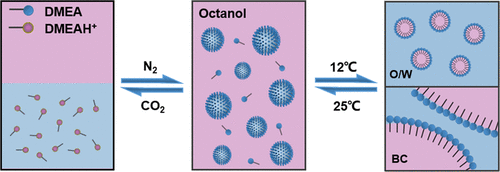Our official English website, www.x-mol.net, welcomes your
feedback! (Note: you will need to create a separate account there.)
CO2 and Temperature Control over Nanoaggregates in Surfactant-Free Microemulsion
Langmuir ( IF 3.7 ) Pub Date : 2021-01-29 , DOI: 10.1021/acs.langmuir.0c03527 Yue Zhou 1 , Shuai He 2 , Huanhuan Li 1 , Yongmin Zhang 1
Langmuir ( IF 3.7 ) Pub Date : 2021-01-29 , DOI: 10.1021/acs.langmuir.0c03527 Yue Zhou 1 , Shuai He 2 , Huanhuan Li 1 , Yongmin Zhang 1
Affiliation

|
Smart microemulsions (MEs) recently have attracted significant interests. However, MEs, especially surfactant-free MEs (SFMEs) that respond to more than one stimulus, are rarely reported to date. Here, we reported the first example of dual-responsive SFME in which a CO2-sensitive hydroxyethylamine was used as an amphisolvent. This SFME was investigated utilizing ternary phase diagram, dynamic light scattering, and UV–visible spectrum techniques. It was found that three hydroxyethylamines could stabilize the octanol–water mixture to form transparent and isotropic SFMEs including nanoaggregates-rich pre-ouzo zone, regardless of the number of the hydroxyl group. Among them, 2-(dimethyl amino) ethanol (DMEA)-based SFME possesses the largest single-phase region and most sensitive to CO2 and the changes in temperature. With bubbling of CO2/N2 or decreasing/increasing temperature, both the single-phase region and pre-ouzo zone reversibly shrink and expand, as well as with breathing. However, CO2/N2-induced change is more significant than that induced by temperature. The former is mainly ascribed to the reversible protonation and deprotonation of DMEA, while the latter is generally interpreted as the effects of temperature on hydrogen bond interaction. Note that CO2 leads to a thorough demusification from Winsor IV ME to oil-rich and water-rich two phases without nanoaggregates, while cooling only causes to a particular phase separation, producing two new MEs phases, not typical Winsor I or II MEs. Such a unique dual-responsive SFME can not only be applied in the remediation of contaminated soil, drug delivery, and nanoparticles preparation but also opens a new door to switchable emulsion.
中文翻译:

无表面活性剂的微乳液中纳米聚集体的CO 2和温度控制
智能微乳剂(ME)最近引起了极大的兴趣。然而,迄今为止,很少报道ME,特别是对多种刺激有反应的不含表面活性剂的ME(SFME)。在这里,我们报道了双反应型SFME的第一个实例,其中将CO 2敏感的羟乙胺用作两性溶剂。使用三元相图,动态光散射和UV-可见光谱技术对该SFME进行了研究。发现三种羟乙胺可以稳定辛醇-水混合物,形成透明且各向同性的SFME,包括富含纳米聚集体的前偶氮区,而与羟基数无关。其中,基于2-(二甲基氨基)乙醇(DMEA)的SFME具有最大的单相区,对CO 2最敏感以及温度的变化 随着CO 2 / N 2鼓泡或温度降低/升高,单相区和前偶氮区都可逆地收缩和膨胀以及呼吸。但是,CO 2 / N 2引起的变化比温度引起的变化更为显着。前者主要归因于DMEA的可逆质子化和去质子化,而后者通常被解释为温度对氢键相互作用的影响。注意CO 2导致Winsor IV ME彻底脱胶成富含油和水的两相而没有纳米聚集体,而冷却仅导致特定的相分离,产生两个新的ME相,而不是典型的Winsor I或II ME。这种独特的双响应SFME不仅可以应用于污染土壤的修复,药物输送和纳米颗粒的制备,而且还为可转换乳液打开了新的大门。
更新日期:2021-02-09
中文翻译:

无表面活性剂的微乳液中纳米聚集体的CO 2和温度控制
智能微乳剂(ME)最近引起了极大的兴趣。然而,迄今为止,很少报道ME,特别是对多种刺激有反应的不含表面活性剂的ME(SFME)。在这里,我们报道了双反应型SFME的第一个实例,其中将CO 2敏感的羟乙胺用作两性溶剂。使用三元相图,动态光散射和UV-可见光谱技术对该SFME进行了研究。发现三种羟乙胺可以稳定辛醇-水混合物,形成透明且各向同性的SFME,包括富含纳米聚集体的前偶氮区,而与羟基数无关。其中,基于2-(二甲基氨基)乙醇(DMEA)的SFME具有最大的单相区,对CO 2最敏感以及温度的变化 随着CO 2 / N 2鼓泡或温度降低/升高,单相区和前偶氮区都可逆地收缩和膨胀以及呼吸。但是,CO 2 / N 2引起的变化比温度引起的变化更为显着。前者主要归因于DMEA的可逆质子化和去质子化,而后者通常被解释为温度对氢键相互作用的影响。注意CO 2导致Winsor IV ME彻底脱胶成富含油和水的两相而没有纳米聚集体,而冷却仅导致特定的相分离,产生两个新的ME相,而不是典型的Winsor I或II ME。这种独特的双响应SFME不仅可以应用于污染土壤的修复,药物输送和纳米颗粒的制备,而且还为可转换乳液打开了新的大门。















































 京公网安备 11010802027423号
京公网安备 11010802027423号